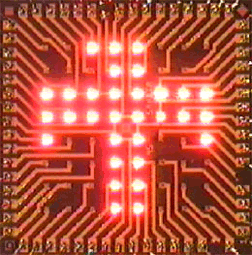NEWS RELEASES
FOR IMMEDIATE RELEASE — January 18, 2005
Media Contact: Michael Padilla, mjpadil@sandia.gov, 505-284-5325
Online database highlights opportunities to license Sandia intellectual property
 VCSEL arrays are among the many Sandia technologies available for licensing via the iPAL database. Sandia has become an internationally recognized leader in photonics technology.
VCSEL arrays are among the many Sandia technologies available for licensing via the iPAL database. Sandia has become an internationally recognized leader in photonics technology.ALBUQUERQUE, N.M. — A new online database created to highlight opportunities to license Sandia National Laboratories’ intellectual property is now available to the general public.
The purpose of Sandia’s Intellectual Property Available for Licensing (iPAL™) database is to show Sandia technologies that may not be fully utilized in the commercial marketplace and to help companies move promising technologies toward commercialization.
“iPAL highlights some of the interesting technologies Sandia has that many people outside Sandia often have never heard of,” says Sandia Licensing and Intellectual Property (IP) Manager Kevin McMahon.
“The database gives the public an opportunity to see if these technologies would be valuable in the commercial world,” adds iPAL developer Kelly Cowan, a graduate student intern studying management of technology.
The web-based system allows customers to search through Sandia intellectual property that is available for licensing and get in touch with the appropriate people at Sandia to negotiate a license. Sandia works with interested companies to execute a mutually beneficial commercial licensing agreement.
“We would expect corporate technology officers at private firms and technology transfer agents at universities and other organizations to look at some of the technologies we are offering and decide if they want to license this IP from us,” says McMahon.
iPAL provides a mechanism to see if anyone is interested in a particular technology, and if Sandia does not get any interest after a period of time, a decision could be made to drop a technology from Sandia’s portfolio.
Large businesses regularly save millions of dollars by actively reviewing their IP portfolios and deciding which technologies they want to keep or drop.
“This is important because with the rapid pace of change in technology, IP developed at the Labs only a few years ago can rapidly become obsolete, or at least no longer be the optimum way of accomplishing its original purpose,” says McMahon. “Therefore, a great deal of perfectly usable technology can fall by the wayside and not be fully utilized.”
iPAL can be found at http://ipal.sandia.gov.
Sandia is a multiprogram laboratory operated by Sandia Corporation, a Lockheed Martin company, for the U.S. Department of Energy’s National Nuclear Security Administration. Sandia has major R&D responsibilities in national security, energy and environmental technologies, and economic competitiveness.